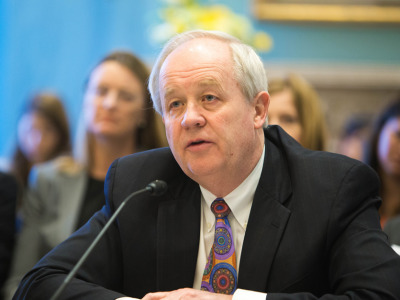The Agriculture Department is releasing early the minimum requirements for a dairy donation program that's much larger than one authorized by the 2018 farm bill, as USDA and the dairy industry hope to avoid another occurrence of last year's market disruption and milk dumping.
The fiscal 2021 omnibus spending bill enacted in December provided USDA with $400 million to use for the new Dairy Donation Program, which reimburses processors that donate products to nonprofits, who then distribute food to needy Americans. The much smaller Milk Donation Reimbursement Program was authorized by the 2018 farm bill and funded with $29 million over five years.
The expanded program "will, at a minimum, reimburse participating dairy organizations for the full value of the raw milk donated to make the dairy product, as opposed to a narrower reimbursement in the MDRP,” Paul Bleiberg, senior vice president of government relations at the National Milk Producers Federation, told Agri-Pulse.
DDP is open to all dairy products, rather than just fluid milk as per the MDRP, he said.
The MDRP allowed eligible dairy organizations to partner with nonprofit organizations that distribute food to low-income individuals and were allowed to apply for and receive limited reimbursements to cover expenses related to certain fluid milk product donations.
Under DDP minimum requirements, applicants must submit a donation and distribution plan and maintain records of donations USDA could audit. The program is open to dairy processors who purchase milk from producers serving a federal milk marketing order. FMMOs establish certain standards where dairy processors purchase fresh milk from dairy farmers supplying a marketing area, according to USDA’s Agricultural Marketing Service.
No one wants to see a repeat of last April when producers began dumping milk because of coronavirus marketplace disruptions.
Michael Dykes, president and CEO of the International Dairy Foods Association, said the program should be viewed as an alternative to dumping milk rather than another commercial opportunity.

Michael Dykes, IDFA
“As we move closer into May (and) June, we’ll be into the peak of spring flush because cows tend to give more milk when the weather warms up,” he told Agri-Pulse.
He said IDFA has talked with USDA about making sure purchases are evenly distributed across the different classes of milk so there isn’t market distortion by using the donation program for only one particular class.
If there is a sudden collapse in butter or cheese prices relative to the price it was at the time when the butter or cheese was produced, then DDP will be activated, and processors may choose to donate the products rather than incur losses in inventory, said Marin Bozic, a dairy economist at the University of Minnesota.
“It’s specifically designed to be that way because we don’t know how the next six months will look. One can tell a rather positive story or scary story,” he said, as more restaurants and schools across the country consider reopening.
If fewer exports cause domestic supplies to grow, and high supplies push butter and cheese prices down, the DDP should provide a “soft landing” for companies, Bozic noted.
He also did not expect DDP to create spikes in cheese or butter prices the way USDA’s Farmers to Families Food Box program did in the summer of 2020.
In June, the food box program was up and running, and the average Class III price hit $21.04 per hundredweight, while the Class I and IV prices remained at just over $14 and under $13 per hundredweight, respectively.
The food box program specifically required the distribution of cheese.
“At the start of the food box program, they were actively bidding for cheese that was already in short supply because a lot of cheese was committed for exports, and that’s what lifted the prices of cheese to record highs in some weeks and months,” Bozic said.
However, one hurdle that could complicate spending is if President Joe Biden removes the current public health emergency due to the pandemic.
Interested in more news on farm programs, trade and rural issues? Sign up for a four-week free trial to Agri-Pulse. You’ll receive our content - absolutely free - during the trial period.
“That may make it more difficult for USDA to use this program. Although the way the bill is written, there is a lot of discretion,” Bozic noted.
In February, U.S. milk production was 2.3% above last year when adjusting for the leap year, according to USDA’s National Agricultural Statistics Service.
Peter Vitaliano, chief economist at the National Milk Producers Federation, said there is usually enough milk available for donation purposes.
Vitaliano said a key question is how many eligible companies decide to participate in the program. Each one will have to assess its supply and customers’ needs before deciding whether they find the reimbursement rate attractive enough to bid into the program, Vitaliano said.
“We just don’t know that at the moment,” he told Agri-Pulse.
The department is expected to begin writing a rule, or formal set of regulations, for the program sometime this summer, Dykes said.
For more news, go to www.Agri-Pulse.com.


